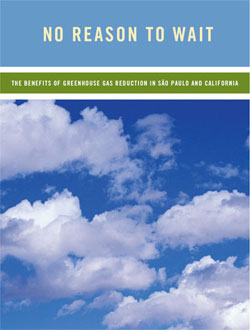Energy efficiency helped California grow an extra $31 billion finds study
mongabay.com
December 4, 2005
SUMMARY: Countering Bush administration claims to the contrary, environmental officials for the state of California and the Brazilian state of Sao Paulo have found significant evidence that greenhouse gas pollution can be substantially reduced at a profit rather than a cost. The study, commissioned by the William and Flora Hewlett Foundation, found that energy efficiency has helped the California economy grow an extra 3 percent – a $31 billion gain – compared to business as usual. Further, the researchers say that each Californian typically saved about $1,000 per year between 1975 and 1995 just through efficiency standards for buildings and appliances.
William and Flora Hewlett Foundation news release
December 1, 2005.
Top environmental officials for the state of California and the Brazilian state of Sao Paulo have found significant empirical evidence that greenhouse gas pollution can be substantially reduced at a profit rather than a cost. The findings, to be presented next week to the United Nations Framework Convention on Climate Change in Montreal, are documented in the first large-scale case studies on the economic impact of reducing greenhouse-gas pollution.
“There appears to be a large opportunity for emission reductions that provide short-term economic and health benefits, and every attempt should be made to promote national policies and international cooperation that can help states, nations, and the world achieve these benefits,” the Secretaries write in the foreword to the study report, No Reason to Wait: the Benefits of Greenhouse Gas Reduction in Sao Paulo and California.
 No Reason To Wait What will it cost to reduce the threat of global warming? Can industrialized nations afford it? Shouldn’t developing countries invest in economic development instead? The future of climate-change negotiations, and the future climate of the planet, hinge on the answers to these questions. This report provides important real-world evidence that greenhouse gas emissions The experience in these states should provide impetus to other state and national |
Conducted by Stanford University scholar Walter Reid and professional staff from the Sao Paulo Department of the Environment and commissioned by the William and Flora Hewlett Foundation, the case studies detail the economic impact of policies in California and Sao Paulo that dramatically reduced the per-capita emissions of greenhouse-gas pollution over the last two decades.
The study found that each Californian produces less than half the greenhouse-gas emissions as his or her fellow American. This is due in large part to state policies encouraging the use of natural gas and renewable resources over coal, as well as the aggressive promotion of energy efficiency. The state’s per capita emissions have dropped nearly one-third since 1975, while the nation’s per capita emissions have stayed flat.
The study notes that each Californian typically saved about $1,000 per year between 1975 and 1995 just through efficiency standards for buildings and appliances. Energy efficiency has helped the economy grow an extra 3 percent – a $31 billion gain – compared to business as usual. The job growth created by the energy-efficiency industry will generate an $8 billion payroll over the next twelve years.
Similarly, the study found that the state of Sao Paulo since 1999 has steadily reduced greenhouse-gas emissions per capita and per unit of economic activity. Examples of state programs driving the reduction are ethanol blending, which is saving consumers $7.5 billion a year, and a national electricity conservation program saving $5 billion that otherwise would have been spent on new power plants.
Copies of the study are available from the Hewlett Foundation at www.hewlett.org/publications/noreasontowait.htm as well as from the State of California at www.climatechange.ca.gov.
Related:
Rainforests worth $1.1 trillion for carbon alone in Coalition nations
11/29/2005 | Mongabay.com
If a coalition of developing countries has its way, there could soon be new forests sprouting up in tropical regions. The group of ten countries, led by Papua New Guinea, has proposed that wealthy countries pay them to preserve their rainforests. The Coalition for Rainforest Nations argues that all countries should pay for the benefits — from carbon sequestration to watershed protection — that tropical rainforests provide.
Carbon in Canada’s boreal forest worth $3.7 trillion
11/25/2005 | mongabay.com
Carbon stored in Canada’s boreal forests and peatlands is worth $3.7 trillion according to research by the Pembina Institute for the Canadian Boreal Initiative. The two-year study puts the value of ecosystem services like water filtration, pest-control services, and carbon storage at $93 billion — roughly 2.5 times greater than the net market value of forestry, hydroelectric, mining, and oil and gas extraction in Canada’s Boreal region.